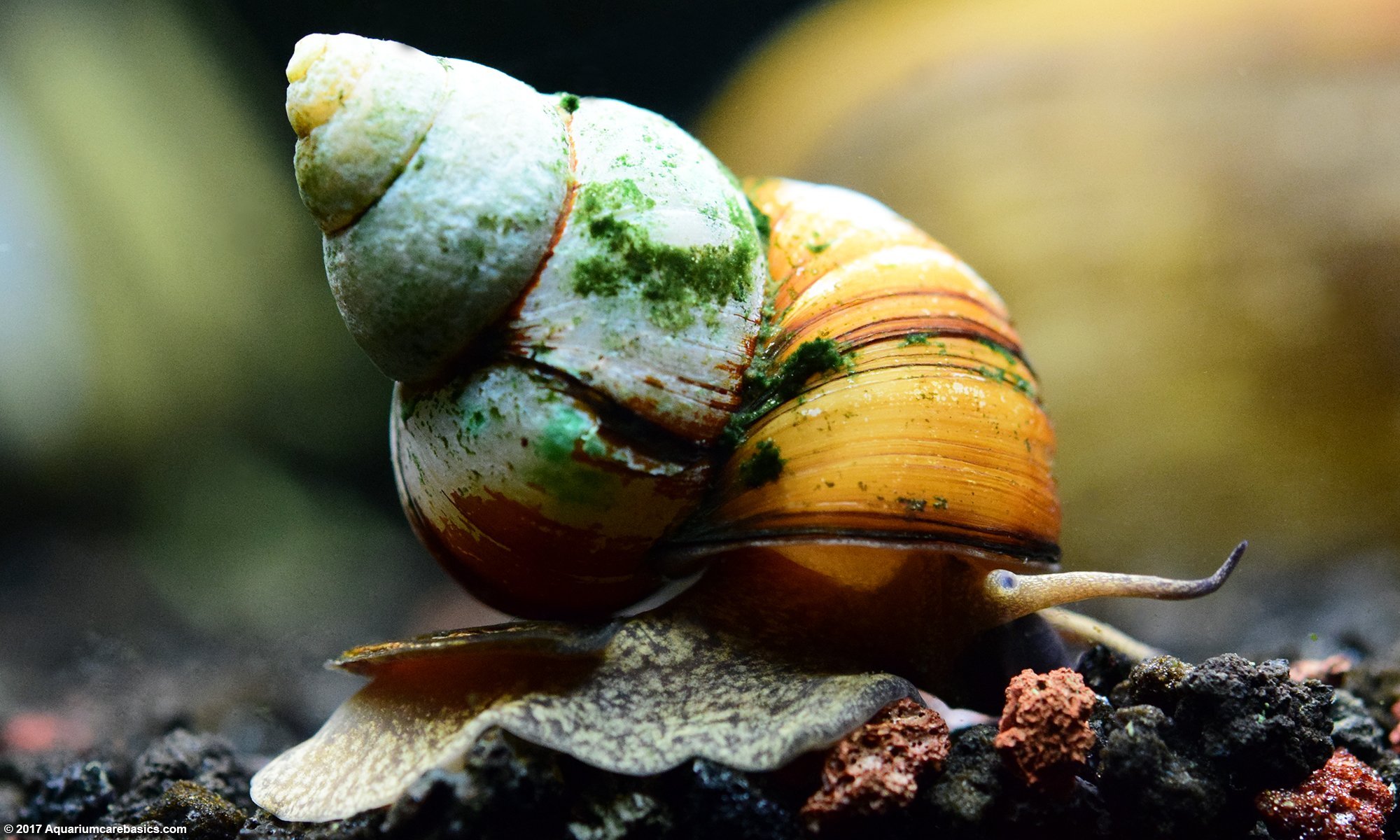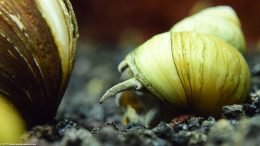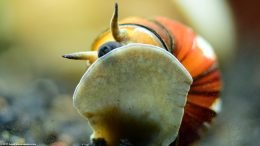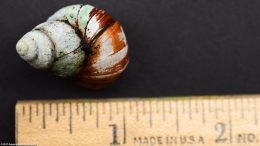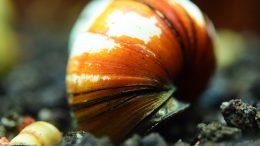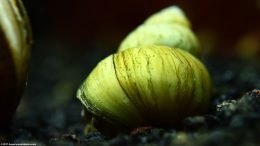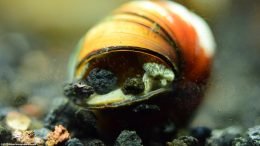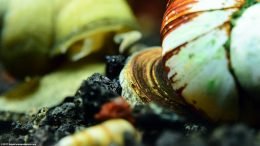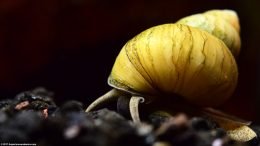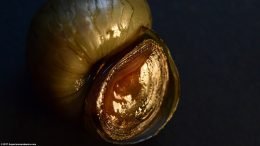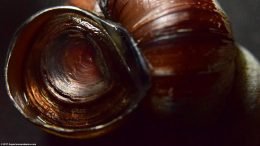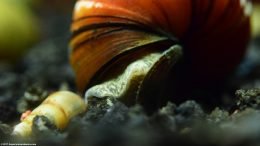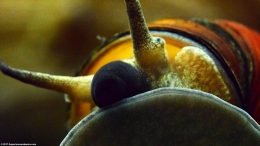One of the more interesting freshwater snails to keep are Japanese Trapdoor Snails. This snail has a reputation of being a very tranquil, non-aggressive soft algae eater. In addition, Japanese Trapdoor Snails will spend hours on end scouring the tank for uneaten food as well as other edible material. Japanese Trapdoor Snails may be marketed as Chinese Mystery Snails or simply as Trapdoor Snails.
Questions regarding Japanese Trapdoor Snails usually involve:
What To Look For When Buying A Japanese Trapdoor Snail In Stores
Where Can I See Japanese Trapdoor Snail Images?
What Are The Japanese Trapdoor Snail Care Issues?
How Big Does A Japanese Trapdoor Snail Get?
How Long Does A Japanese Trapdoor Snail Live?
What Is A Good Japanese Trapdoor Snail Tank Size?
What Does A Japanese Trapdoor Snail Eat?
Does A Japanese Trapdoor Snail Eat Live Plants?
What Are Good Japanese Trapdoor Snail Tank Mates?
What About Japanese Trapdoor Snail Breeding In Aquariums?
When Buying Japanese Trapdoor Snails
When buying Japanese Trapdoor Snails look for specimens appearing healthy and active in the display tank. Japanese Trapdoor Snails should be stuck on hard surfaces or moving across the tank bottom. Their two eyes and tentacles should be present, and their operculum should be visible above their foot, near their backside.
Shells should appear free from cracks, holes, excessive pitting, or other visible damage, as this can be an indication the snail has been living in less than ideal water conditions for quite some time.
Avoid snails that appear upside down, motionless in the tank, or floating near the surface. These can be indications that the snail is sick, dying or dead. Also avoid snails that come from display tanks with visibly sick or dead tank mates, as this can be an indication of unhealthy conditions. Finally, its not uncommon for a Japanese Trapdoor Snail to have some algae growth on its shell.
Japanese Trapdoor Snail Video: 30 seconds
Images Of Japanese Trapdoor Snails, Upclose
Japanese Trapdoor Snail Care Issues
One of the best things about Japanese Trapdoor Snail care is that its relatively simple. But there are a few things to keep in mind. Since Japanese Trapdoor Snails don’t have a siphon like Gold Inca Snails, they do not go to the water surface to take in air. Still, the tank should be covered to the extent possible. Trapdoor Snails can accidentally escape from a tank, become injured and die.
Filter Intakes: Another Japanese Trapdoor Snail care issue involves filter intakes. Hungry snails often graze across filter intakes in search of food. Sometimes, they find themselves caught in the slats. In many cases, the snails are unable to wiggle their way free. Attempts to remove them often end up with serious or fatal injuries. So when keeping these snails, its a good idea to keep filter intakes covered with a course sponge filter for safety. Finally, its a good idea to make sure snails are added to a tank with the aperture facing down. This way, they do not have to turn over to start moving about the tank.
Shell Color & Texture: A Japanese Trapdoor Snail shell color range can include varying shades of black, dark green, or olive green, as well as varying shades of dark brown, reddish brown and light brown. Shell colors can be solid or have different colors within the range, and its not uncommon for shells to have large areas of white on the spire close to the apex. Texture is relatively smooth compared to the texture of some other snails like Rabbit Snails. A Trapdoor Snail shell texture is slightly grooved resulting from the snail’s growth lines.
Tank Conditions
Water Parameters: A Japanese Trapdoor Snail is adaptable to a wide range of water conditions, so keeping them in a tank with traditional community tank parameters should not be a problem. That said, its important to add the snails to a stable, cycled, established tank that is otherwise healthy. Though hardy, sudden shifts in water parameters can stress the snails and cause them harm. So the key is to try to keep things on an even keel.
Aquarium pH: 7.0 to 7.6, with suggestions a wider range is acceptable
Hardness/Minerals: Minerals are necessary for healthy shells
Temperature: 72 – 80 Degrees Fahrenheit, with a wider range acceptable
Lighting: Regular community tank lighting will suffice
Its necessary to keep Ammonia and Nitrite levels at 0 ppm, and Nitrate levels low with regular partial water changes. Also, Japanese Trapdoor Snails should not be exposed to Copper as it can be fatal to them. And be sure to check any plant fertilizers used to ensure they are shrimp and snail safe.
Size & Growth Rate
Japanese Trapdoor Snail Size: In general, Japanese Trapdoor Snail size is related to the age of the snail. The older the snail, the larger it should be, all things equal. Other factors related to size can be the snail’s diet and the levels of Calcium in the tank. Another interesting thing about Japanese Trapdoor Snails is their relatively wide aperture, and the fact that they have a large operculum that seals the aperture shut in the event the snail is bothered by a tank mate.
In stores, most Japanese Trapdoor Snails will be between a half inch and one inch long. Some hobbyists have said Japanese Trapdoor Snails can grow to be between two and three inches long.
Lifespan & Growth Rate: Under the best conditions, and with a little bit of luck, Japanese Trapdoor Snails can live for about 1 to 5 years, and maybe a bit more. Its also common for Japanese Trapdoor Snails to die soon after being introduced to their new home. Possible reasons for sudden death can include stress associated with being transported from the store, the shift in water parameters between the display tank and the home tank, or simply the snail itself. So care should be taken to add snails to the tank as gently as possible, giving the snail sufficient opportunity to gradually become accustom to their new water and environment.
Motionless Snails
Dead Snails: Its also not uncommon for Japanese Trapdoor Snails to lay motionless on the tank bottom for long periods of time. They can lay still with the operculum sealed shut, or slightly open with a parts of their bodies exposed. This behavior does not necessarily mean they are sick, dying or dead. It may simply mean they are just taking a break. So keep close tabs on the snail to learn its behavior.
If the snail is motionless for longer than ordinary, tap it gently to see if it moves. If it doesn’t move, or begins to float, gently remove the shell with a net. A dead snail has a remarkable, repugnant, and unmistakable smell. If the snail is still alive, gently return it to the tank, aperture side down, and keep an eye on it. Dead snails should be removed from the tank as soon as possible as they can decompose very quickly and cause water quality issues, like smelly cloudy water and Ammonia spikes.
Habitat & Enviroment
Tank Size & Habitat: A Japanese Trapdoor Snail can be kept in small tanks like a 10 gallon aquarium, or larger sizes. Just keep in mind that snails, like other organisms, add to the tank waste being produced, so avoid overstocking. Japanese Trapdoor Snails can be kept in tanks with clear quick moving water, or tanks on the murkier side. But either way, make sure the tank is well sufficiently filtered, properly oxygenated, and has the ability to supply enough naturally occurring soft algae for them to eat in between feedings. Japanese Trapdoor Snails can be very active in low light settings as well as at night, so be sure to have the tank set up with plenty of places for them to explore. Japanese Trapdoor Snails can do well in community tanks as well as in snail tanks and shrimp tanks.
Food Choices
Diet & Feeding: One of the benefits of keeping Japanese Trapdoor Snails is that they are great little scavengers and algae eaters. They will spend hours moving about the tank looking for food to eat. But while they will help keep a tank clean by eating leftovers, their diets should include food specifically for them. Japanese Trapdoor Snails seem to be very interested in fish flakes, bottom feeder tablets, pellets, and other foods rich in Calcium.
Japanese Trapdoor Snails may also like to eat a variety of fresh vegetables. Experimenting with blanched spinach, zucchini and lettuce may be a good start. Offer the snails fresh vegetables one at a time, in small amounts, and observe what happens. Leave the vegetable in the tank for a day or so. If the snail is not interested within 24 hours, remove the vegetable and try another. More often than not, hobbyists will find what the snail likes after a couple of tries.
In addition to supplements and fresh vegetables, Japanese Trapdoor Snails are very interested in eating soft algae from hard surfaces, especially at night. So be sure to leave some algae growing on the glass for the snail to feed. In addition to naturally occurring algae, Japanese Trapdoor Snails may also be interested in algae wafers.
About Live Plants
Japanese Snails Eating Live Plants: Many hobbyists like to keep Japanese Trapdoor Snails in tanks with lots of live aquarium plants. Planted tanks are never “too clean”, and there is always a constant source of dead plant matter for snails to eat. As to the question of whether Japanese Trapdoor Snails will eat the live plants themselves, the answer depends on how hungry the snail is, what kind of plants are being kept, and the nature of the individual snail. Keeping Japanese Trapdoor Snails well fed and on a diet of fresh green vegetables can be a good ways to ensure the aquarium plants will not be devoured. Another thing to think about is the type of plants being kept. Plants with thick durable and hardy leaves, like Anubias, will be less likely to be eaten than those of the more delicate varieties.
Trapdoor Snails: Breeding & Reproduction
Its important to note that Japanese Trapdoor Snails are able to breed in freshwater aquariums. But Japanese Trapdoor Snail reproduction its generally not a problem compared to other freshwater snails, like Malaysian Trumpet Snails or Pond Snails. Japanese Trapdoor Snail reproduction occurs less frequently, and they are not likely to overrun a tank. Finally, Japanese Trapdoor Snails are live bearers, so they don’t lay hard eggs on surfaces like Nerite Snails do.
Japanese Trapdoor Snail Tank Mates
Because Japanese Trapdoor Snails are docile and peaceful, they should be kept in tanks that are free from predators that can harm or kill them. Good tank mates include others of their kind, as well as many other community tank fish. Cory Catfish and Otocinclus Catfish are good choices and they are also calm and peaceful. Freshwater filter feeding shrimp like Viper Shrimp and Wood Shrimp can also be good choices. Japanese Algae Eating Shrimp, Red Cherry Shrimp and Ghost Shrimp are also a good fit. Other snails including Nerite Snails, Ivory Snails, Gold Inca Snails, Ramshorn Snails, Trumpet Snails and Mystery Snails will mesh well too.
Avoid roughens like Oscars and other cichlids, Goldfish and Aquarium Crayfish. As with other purchases, be sure to check with the store clerk if there are any questions regarding compatibility.

